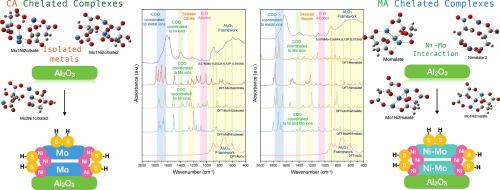Ni-MoS2和2Ni-MoS2对加氢裂化菲的杂化和协同催化的原子尺度见解:柠檬酸定向的NiS2和MoS2对选择性短链单芳烃的综合研究以及苹果酸定向的Ni-MoS2和2Ni-MoS2对选择性长链单芳烃的综合研究
IF 6.9
2区 材料科学
Q2 CHEMISTRY, PHYSICAL
引用次数: 0
摘要
本研究以柠檬酸(CA)和苹果酸(MA)为配体,探讨了配体定向合成 NiS2、MoS2、Ni-MoS2 和 2Ni-MoS2,并得到了实验结果和密度泛函理论(DFT)计算的支持。CA 被用来制备分离的 NiS2 和 MoS2,而 MA 则促进了双金属 Ni-MoS2 和 2Ni-MoS2 的形成。对这些催化剂在菲(PHE)加氢裂化中的性能进行了评估,结果表明它们具有不同的产品选择性。孤立的 NiS2 和 MoS2 由于氢溢出有限和中间体结合力强,主要生成短链单芳香族产品,而 Ni-MoS2 和 2Ni-MoS2 则由于氢溢出增强、Ni-Mo 相互作用协同和中间体稳定性提高,选择性地生成长链单芳香族产品。CA 衍生的 NiS2 和 MoS2 在活性位点表现出很强的结合力,但动态相互作用有限;而 MA 衍生的 Ni-MoS2 和 2Ni-MoS2 则表现出适度的吸附能和高效的电荷转移,有利于选择性氢化和键的裂解。这些发现凸显了配体选择在定制催化剂结构和电子特性方面的关键作用,为优化加氢裂化工艺和实现理想的产品分布提供了合理的设计策略。本文章由计算机程序翻译,如有差异,请以英文原文为准。


Atomic-Scale insights into hybridization and synergistic Catalysis of Ni-MoS2 and 2Ni-MoS2 for hydrocracking phenanthrene: A comprehensive study of Citric Acid-Directed NiS2 and MoS2 for selective Short-Chain monoaromatics and Malic Acid-Directed Ni-MoS2 and 2Ni-MoS2 for selective long-chain monoaromatics
This study explores the ligand-directed synthesis of NiS2, MoS2, Ni-MoS2, and 2Ni-MoS2 using citric acid (CA) and malic acid (MA) as ligands, supported by experimental results and density functional theory (DFT) calculations. CA was employed to prepare isolated NiS2 and MoS2, while MA facilitated the formation of bimetallic Ni-MoS2 and 2Ni-MoS2. The catalysts were evaluated for their performance in the hydrocracking of Phenanthrene (PHE), revealing distinct product selectivity. Isolated NiS2 and MoS2 predominantly produced short-chain monoaromatic products due to limited hydrogen spillover and strong binding of intermediates, whereas Ni-MoS2 and 2Ni-MoS2 selectively formed long-chain monoaromatics, driven by enhanced hydrogen spillover, synergistic Ni-Mo interactions, and improved intermediate stabilization.
DFT calculations provided insights into the ligand effect on electronic structures and catalytic properties. CA-derived NiS2 and MoS2 exhibited strong binding at active sites but limited dynamic interactions, while MA-derived Ni-MoS2 and 2Ni-MoS2 demonstrated moderate adsorption energies and efficient charge transfer, favoring selective hydrogenation and bond cleavage. These findings highlight the critical role of ligand choice in tailoring the structural and electronic properties of catalysts, offering a rational design strategy for optimizing hydrocracking processes and achieving desired product distributions.
求助全文
通过发布文献求助,成功后即可免费获取论文全文。
去求助
来源期刊

Applied Surface Science
工程技术-材料科学:膜
CiteScore
12.50
自引率
7.50%
发文量
3393
审稿时长
67 days
期刊介绍:
Applied Surface Science covers topics contributing to a better understanding of surfaces, interfaces, nanostructures and their applications. The journal is concerned with scientific research on the atomic and molecular level of material properties determined with specific surface analytical techniques and/or computational methods, as well as the processing of such structures.
 求助内容:
求助内容: 应助结果提醒方式:
应助结果提醒方式:


